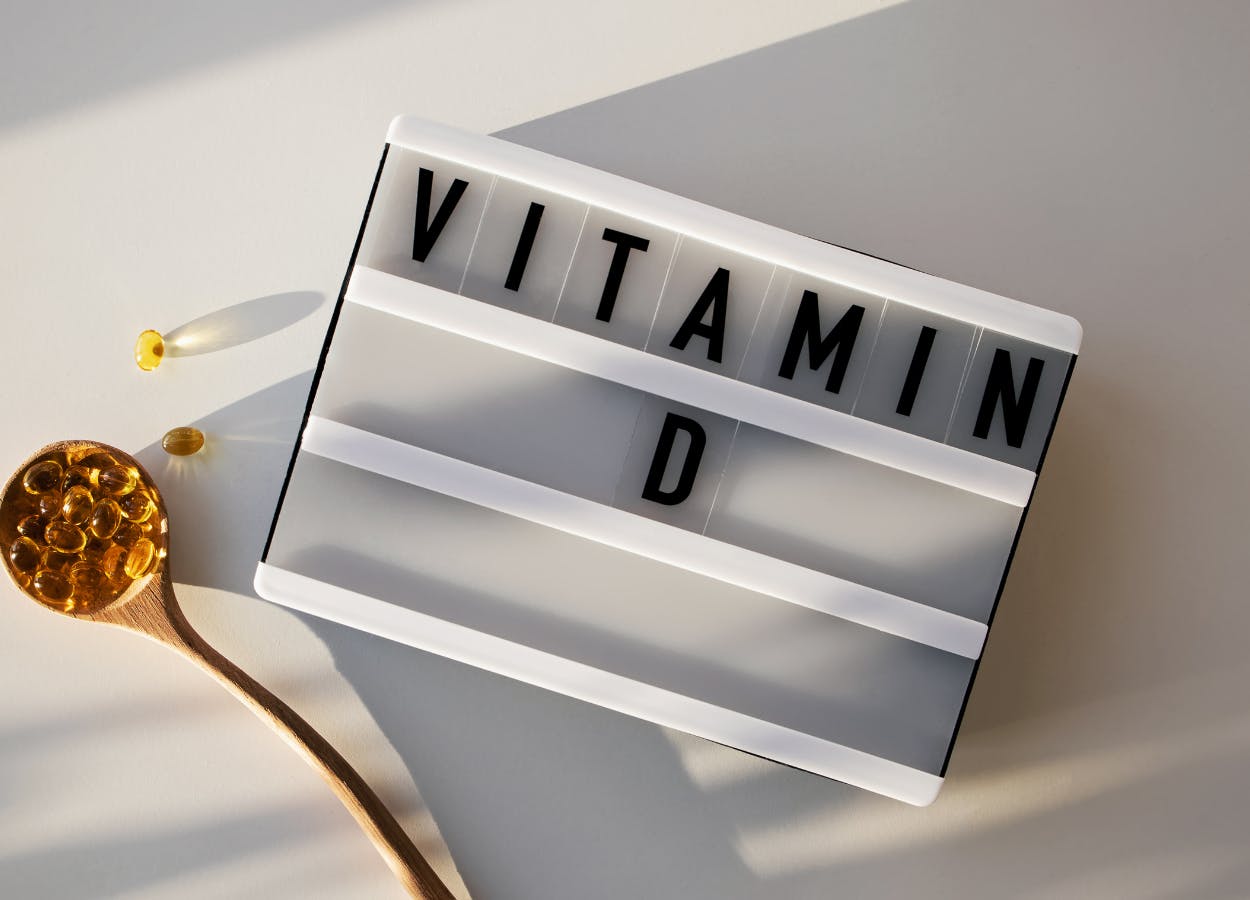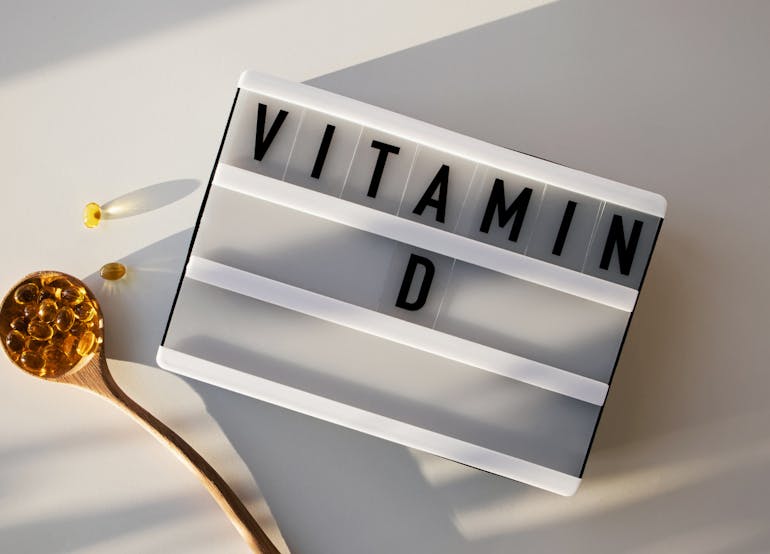How to increase Vitamin D naturally?
Reviewed and fact-checked by Giulia Guerrini, Superintendent Pharmacist. Read our editorial policy to see how we create informative, accurate content.
Vitamin D is an essential nutrient that aids your body in maintaining strong and healthy bones, so it’s important to make sure you’re getting enough. But since most people’s source of vitamin D comes from the sun (and let’s face it, we live in the UK), it’s pretty common to be vitamin D deficient. Having low vitamin D can be a big health issue, so if you suffer from low vitamin D (or just want to make sure you’re giving your body enough of this important vitamin), read our advice on handy ways to increase vitamin D naturally.

What is Vitamin D?
Vitamin D is an important vitamin for our bodies: it helps to regulate calcium and phosphate, keeping our bones, teeth, and muscles healthy. Vitamin D also plays a role in our body’s immune and nervous systems. Known as the sunshine vitamin (catchy name, isn’t it?), our bodies can create vitamin D from direct sunlight, but we can also get vitamin D from certain foods. Because vitamin D plays such a vital role in our bodies’ development and management, you need to keep your levels topped up. During the winter months it can be difficult to get enough sunshine exposure, so it’s common to have low levels of vitamin D – but since it’s vital for our bodies, a lack of vitamin D can affect you negatively and even lead to serious health conditions such as rickets in children, and osteomalacia in adults.
How to increase Vitamin D?
To make sure that your body is getting enough vitamin D, there are lots of natural ways that you can raise your vitamin D levels quickly.
1. Spend more time in the sun
Who doesn’t love an excuse to get out in the sunshine? One of the best and easiest sources of vitamin D is the sun. Your body has a type of cholesterol that makes vitamin D when exposed to sunlight on the skin. However, how much vitamin D your body can make depends on a few factors, including your skin tone and age. People with darker skin tones have more melanin, which can inhibit vitamin D production, so people with darker skin need to spend more time outside to produce vitamin D. With age, the older you get the less efficient your skin is at producing vitamin D, too. Most people can make enough vitamin D from being out in direct sun daily for short periods with your arms, hands, or lower leg skin exposed. Because there are factors that can affect how much vitamin D is made, there is no official recommended amount of time you should be exposed to the sun. But, if you’re staying in the sun for long periods of time, the risk for skin cancer increases, so you should cover up and protect your skin from both sunburn and cancer with sunscreen. Read our guide on How to Wear Sunscreen for a full rundown of why you need it, the different types of sunscreen, and how to properly apply for more info. We always recommend wearing sunscreen, and being protected where you can – so if you’re not getting all you need from the sun (or if it’s just not that sunny where you are), there are other methods to get all the vitamin D you need.
2. Eat foods that are rich in vitamin D
Another way you can increase your vitamin D naturally is by eating more food that contains vitamin D. There are few vitamin D foods, and many have only low levels; however a balanced diet including these vitamin D natural foods may rise your levels.
Fatty fish and seafood
Seafood isn’t just delicious: it’s rich in omega-3 fatty acids, good for your heart, and is among the richest natural food sources of vitamin D. The exact vitamin D content of seafood all depends on the type and species, but fish that are high in Vitamin D include: tuna, shrimp, mackerel, oysters, salmon, sardines, and anchovies. Raw fish has more natural vitamin D than cooked fish, so if you are a fan of sushi or ceviche, eating more is a good idea.
Red Meat
Liver and red meat, such as beef, lamb, mutton, and pork have high levels of vitamin D. However, too much red meat will interfere with your digestion and is high in cholesterol, so it’s important to not eat too much as the benefits might not outweigh the negatives for your health. With pork, the amount of vitamin D depends on the cut and back fat. For example, spare ribs contain the most vitamin D. Deli meats also contain levels of vitamin D: for meats with higher levels of vitamin D opt for salami, beef, pork, or bologna.
Mushrooms
Mushrooms are the only plant-based food that is a natural source of vitamin D – so if you’re vegan or vegetarian eating more mushrooms is a great way to get more vitamin D. Like humans, mushrooms can make their own vitamin D with sunlight exposure. The amount of vitamin D depends on the type of mushroom: shiitake mushrooms and wild mushrooms usually have more vitamin D (but be careful before you take up foraging – to avoid poisonous mushrooms, always purchase from trusted sources such as farmers or supermarkets).
Eggs
Eggs are another food that has a good source of vitamin D, with egg white being a great source of protein and egg yolk containing several nutrients including vitamin D. Like other foods, the egg yolk’s amount of vitamin D depends on various factors, including (interestingly) how much sunlight the chickens are getting. Research suggests that free-range eggs have a greater source of vitamin D as those chickens have more access to sunlight than chickens that remain indoors. It’s also better for the chickens, too.
Dairy Products
Dairy foods and products such as cheese, butter, and cows’ milk are all sources of vitamin D. However, in the UK, cows’ milk isn’t fortified so it’s generally only contains low amounts of vitamin D. Plant-based milk and dairy alternatives such as soy, almond, and hemp milk are all good sources of vitamin D, too. This is because plant-based milk alternatives are fortified to contain more levels of vitamin D – so if you have dietary requirements or follow strict diets such as veganism, adding these milks into your diet is a great way to increase your vitamin D levels naturally.
Vitamin D-fortified foods
Because few foods contain high levels of vitamin D naturally, many staple foods are fortified, which means that vitamin D is often added. However, like other foods, the amount of vitamin D in these fortified foods vary by country, brand, and type. Among plant-based dairy and milk alternatives, other vitamin D-fortified foods include orange juice, ready-to-eat cereals, yogurt, and tofu (another great source of vitamin D for vegans and vegetarians).
3. Take a vitamin D supplement
With the sun’s rays being determined by the time of year, and foods having low levels of vitamin D unless fortified, it can be hard to boost your vitamin D levels without a little bit of outside help. So, taking supplements is a good way to make sure that you’re getting enough vitamin D. Vitamin D can be found in many multivitamins and supplements, in a range of different formats – so it’s easy to find one that works for you. Some of our most popular include:
- For chewable tablets, check out Evacal D3 1500mg chewable 56 Tablets.
- For traditional Vitamin D pills or tablets, try Valupak Vitamin D3.
- Vitamin D Liquids are becoming more popular, too. Check out one of our best sellers, Nutri Advanced D3 Drops with K2 30ml.
- If you follow strict diets such as veganism or vegetarianism, try these Cytoplan vegan vitamin D supplements or Cytoplan vitamin D tablets for vegetarians.
Vitamin D is key for keeping your body healthy and working as it should, so it’s really important to keep your levels topped up. Most people can increase their vitamin D naturally with a well-balanced diet and spending time in the sun, but if you need a bit of help, take a look at our vitamin D supplements – all ready for next day delivery.

